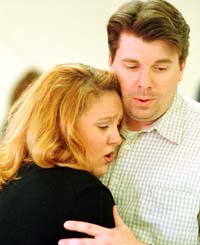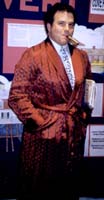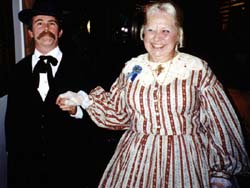At the Naval Academy,
Love According to Mozart
photo by Scott Dine
At Dress Rehearsal: Richard Crawley plays Naval officer Fernando who tests the fidelity of his lover, played by Lori Hultgren.
 Trickery, deceit, lovers in disguise who play comic charades. The latest hit movie? Not quite. That's what you'll see at The Annapolis Opera's production of Mozart's Cosi fan tutte, a comic tale of two 19th century officers at our own United States Naval Academy who go to extremes to test the strength of love. Trickery, deceit, lovers in disguise who play comic charades. The latest hit movie? Not quite. That's what you'll see at The Annapolis Opera's production of Mozart's Cosi fan tutte, a comic tale of two 19th century officers at our own United States Naval Academy who go to extremes to test the strength of love.
What? you say. Mozart at the Naval Academy? Impossible. Wolfgang Amadeus Mozart died in 1791, well before the founding of Naval Academy in 1845.
Somebody better tell the Annapolis Opera quick, before they go to all the trouble of staging a full-blown fallacy.
Not to worry, Annapolis Opera president Anna Marie Darlington-Gilmour is well aware of the discrepancy. "Cosi fan tutte is an opera typical of Mozart in his lightest moments," says Darlington-Gilmour. Those lighter moments have proved irresistible over three centuries, tempting directors to adapt it to their own times and cultures. "This opera has been staged under more different titles than any other," Darlington-Gilmour says.
This time, the guiding hand of stage director Braxton Peters adds an exclusive touch, transforming the soldiers in the cast to naval officers. "Annapolis people love their Naval Academy," says Peters. "Setting the scene here is a good way to add local interest and hopefully attract a new audience."
Love is another attraction, and with spring bursting, there couldn't be a better time for this operatic masterpiece. Subtitled "The School for Lovers," Cosi fan tutte is the creation of two infamous lovers. Storyteller Lorenzo Da Ponte was exiled from most of Europe due to his amorous misadventures, and Mozart himself was no stranger to love.
Mozart a la Annapolis begins as two handsome young officers, Guglielmo, sung by baritone Arturo Chacon, and Ferrando, sung by tenor Richard Crawley, discuss the virtuous fidelity of their true loves. A wealthy Annapolis woman and her sister, they are Fiordiligi, sung by soprano Angela Fout and Dorabella, sung by mezzo-soprano Lori Hultgren. The men are convinced that nothing can rock the foundation of steadfast love.
Enter the older and wiser Don Alfonso, sung by bass-baritone Robert Cantrell. Amused by the naïveté of the young men and eager to reveal the fickle ways of women, he delights in planting a seed of doubt in the minds of the confident lovers. To that end, he proposes a bet. Thus begins a rollercoaster of calamity and chaos.
Will traditional opera-goers accept this deviation from the original?
"Cosi fan tutte is an opera that can stand to be told in any decade or century. Its timeless message is still the same," says soprano Fleta Hylton.
Hylton, who's sung leading roles around the world in her rich career, has appeared with the Annapolis Opera since the early 1990s. In Annapolis, she last sang in "Mozart by Candlelight" in 2000. She is enjoying her "juicy" role as the meddling, puckish maid Despina. Mozart, she says, loved to put such characters in his operas and set them demanding singing tasks as well as keeping the plot moving.
Setting a demanding pace of his own is stage director Peters. A voice teacher by day, he has been working three hours a night with the performers in preparation for the March 30 opening. Rehearsal must move fast; the cast met for the first time less than two weeks ago and has only one more week to perfect the show.
photo courtesy of United States Naval Academy Archives
The Naval Academy’s Midshipmen quarters, circa 1897.
The phenomenally short amount of time is a credit to all involved. "These singers are professionals. They already know the parts when they come in here," says Peters. Not an easy feat considering most operas are sung in a language other than English. This one is Italian, with its rhymes, fast pace and tongue twisters.
Rehearsing on that short deadline, the company fills the upstairs of Asbury Methodist Church with emotion and energy. Dressed in street clothes, they look like ordinary people - until they open their mouths. Then, song explodes like a rare orchid bursting into bloom.
Tonight, the young officers have accepted Don Alfonso's bet. Returning in disguises, each tries to seduce the others' lover to test what he hopes to be her constant devotion. Apparently downcast even to death on being refused, the two handsome young Naval officers seem to drink poison and die.
The ease with which the performers sing disguises the fact that what they do is hard work. Even when the singer is stretched out on the floor in the throes of apparent death, a strong, clear voice reaches out into the audience.
"You've got to be loose and in really good physical shape" says Hylton. "Then imagine adding an elaborate costume and a heavy wig."
It's she, as the conniving maid Despina, who appears in the muddle to manage to keep the men and merriment alive. But who ends up with whom? Mozart keeps you guessing.
Together the talented cast possess many achievements. The senior members of the cast are Hylton and Robert Cantrell, the worldly Don Alfonso. A professor at the Baltimore School for the Arts, he performs with the Washington Opera and many other companies. He sang with the Annapolis Opera in 1996 and 1999.
Baritone Arturo Chacon, a native of Costa Rica, is more familiar to Annapolis audiences, for he performedin Annapolis Opera's Rigoletto last fall and in "Mozart by Candlelight" in December. Chacon's Guglielmo is sponsored by Provident Bank of Annapolis. Annapolis Opera relies on such sponsorship to help connect the community with the fine arts and to give a boost to upcoming talent.
Also sponsored are Cosi's two heartbroken sisters, Angela Fout, by the Helena Foundation, and Lori Hultgren, by William S. Boldyga. Those two have had leading roles in numerous operas. Fout, the first prize winner in the Annapolis Opera Vocal Competition in 2000, last sang with the opera in 1999. In this year's competition, Hultgren won second prize, the $900 Dr. Paul and Mrs. Herta Lagally memorial award. She last appeared with the Annapolis Opera as Maddalena in Rigoletto.
Crawley, singing Ferrando, holds degrees from the Peabody Conservatory and the Eastman School of Music. He makes his Annapolis Opera debut in this production.
In Bay Country, the Annapolis Opera not only brings us Mozart with a local touch but also talent normally heard only in major cities. Upcoming is a spectacular evening of beautiful music, incredible singing and dramatic artistry. Forget stale thoughts of opera glasses and high society. This is our opera. Come to enjoy.
Cosi fan tutte (sung in Italian with English surtitles) plays Friday, March 30, 8pm and Sunday, April 1, 3pm @ Maryland Hall for the Creative Arts. rsvp-$45: 410/267-8135.
The Eagle Has Landed — Among Us
photo by Don Avery
Don Avery, of Deale, has several times seen this eagle and its nesting mate along Parkers Creek.
 Don Avery has been keeping his eye on a pair of bald eagles around his ancestral home near Parkers Creek in Deale. From there he can look out across Herring Bay and see them flying over the water. He also sees them from his car, and, in the last five years, all over the place. Don Avery has been keeping his eye on a pair of bald eagles around his ancestral home near Parkers Creek in Deale. From there he can look out across Herring Bay and see them flying over the water. He also sees them from his car, and, in the last five years, all over the place.
These year-round eagles are part of Maryland's growing population of nesting bald eagles. They are, in all probability, the same eagles that have a nest near the site of the proposed Safeway in Deale. Avery isn't the only one who's noticed an increased eagle presence throughout Chesapeake Country. There's been a sixfold increase in the number of bald eagles nesting in Maryland since 1977, from 41 that year to 270 in 2000.
Those aren't the only eagles in Chesapeake Country. In addition to its healthy and growing nesting population, the Bay and its tributaries attract hundreds of winter visitors.
On the January day of its mid-winter bald eagle survey, Maryland Department of Natural Resources counted 336 bald eagles and two golden eagles in the state's three main winter resorts. Blackwater Wildlife Refuge, on the Eastern shore, accounted for the two golden eagles plus 99 bald eagles. At Aberdeen Proving Ground, 186 bald eagles were counted. And 51 bald eagles were counted along the Susquehanna River.
Those numbers are the highest since the survey began, in 1979. As the population increases, its range is expanding up the Potomac into Western Maryland and near large reservoirs such as Loch Raven, Liberty and Tridelphia.
How do the counters tell residents and visiting eagles apart? In the mid-Atlantic region, eagles begin nesting in January, so adult birds that nest outside of the concentration areas, along the Patuxent for example, would not be present for the count.
All told, our eagles fall into three distinct populations. First are the adult eagles, such as the Deale eagles, that have established nests. These home-loving birds have a strong tendency to stay in the region year round. Second are juveniles that were hatched here. Too young to breed, they may wander up and down the Atlantic seaboard. But many of those return to their native land, and some never leave Bay Country. The third group is a combination of breeding birds and immatures from the northeastern U.S. and Canada that migrate to the Chesapeake for the relatively mild winters and to find food.
You can be fairly certain that the Deale eagles - or any eagles that nest in Chesapeake Country - were hatched in either Maryland or Virginia. According to Department of Natural Resources' eagle expert Glen Therres, most of the eagles that nest in Maryland were themselves hatched in nests along the wooded shoreline of tidal tributaries.
Once listed as an endangered species, bald eagles have bounced back from the brink of extinction after widespread use of the pesticide DDT decimated eagle populations throughout the lower 48 states. By the early 1970s, eagles, osprey, brown pelicans and peregrine falcons were all nearly wiped out.
The return of the eagles is one of the great environmental success stories, but seasoned environmentalists share a fundamental belief: Environmental victories are never permanent. Potential threats, known and unknown, will always exist.
Predators such as eagles need a healthy and productive prey base to continue the positive trends of the last three decades. The good news is that there are no indicators of problems with the eagles' prey base now, according to Therres. Habitat destruction is a perpetual threat, not only to eagles but to many forms of wildlife and plants. Loss of nesting and shoreline habitat within one mile of tidal water is a particular threat to bald eagles.
Which brings us back to Deale, where eagles nest and development looms. The Deale scenario is a harbinger of future conflicts all around the Tidewater as two trends intersect: economic development and the return of the bald eagle to the places the birds have inhabited since the Pleistocene epoch. Engineers, planners, politicians and activists will have their comments for the record, but in the end it is possible that no person or group may have as much say in the matter as a pair of bald eagles. Among the creatures of Chesapeake Country, eagles have a high profile, and - in issues of politics and economic development - considerable clout.
From Stocking to Cap:
Dressing Three Centuries of Marylanders
photo by Leslie King
Baltimore columnist-curmudgeon H.L. Mencken (Bay Weekly general manager Alex Knoll).
W hen Marylanders from three centuries met at Calvert Marine Museum last week, guess what they talked about. Not the transformation of their open land into a suburb. Not roads smooth as silk. Not supermarkets so stocked with edibles that entire villages could feast there for a year. hen Marylanders from three centuries met at Calvert Marine Museum last week, guess what they talked about. Not the transformation of their open land into a suburb. Not roads smooth as silk. Not supermarkets so stocked with edibles that entire villages could feast there for a year.
No, they talked about clothes. How did the length of pantaloon worn by Leonard Calvert in 1634 compare with the Frederick True's knickers in 1908? How did the floor-sweeping hem Mistress Margaret Brent wore in 1648 compare with the short skirt flapper Amber Court donned in 1921?
Accuse them of frivolity, if you will, but temper your judgment on several points.
First, neither race nor creed, neither color nor gender determined membership in this august company of 41 Marylanders. Black and white, woman and man, commoner and lord were gathered as equals. So Benjamin Banneker, born a slave and made an abolitionist, stood on equal footing with U.S. Supreme Court Justice Roger Brooke Taney who, in the Dred Scott decision, ruled that the U.S. government could not forbid slavery. Lighthouse keepers and steamboat captains chatted with governors and lords. Blues diva Billie Holiday passed the time with Red Cross founder Clara Barton. In a fair and egalitarian society, many topics fall by the wayside. But you can't do without clothes.
Second, acknowledge that clothes really do make the woman and man. In collarless shirt, Eubie Blake appeared in the flesh, and petty Officer First Class Wilbur W. Hurley Jr. receded. In hooped skirt, hanged Lincoln assassination conspirator Mary Surratt appeared and Calvert County Commissioner Linda Kelley disappeared. In smoking jacket and slippers, Baltimore Sun columnist and curmudgeon H.L. Mencken flourished and Bay Weekly general manager Alex Knoll faded.
Third, admit that this was, after all, a fashion show.
photo by Leslie King
John Wilkes Booth (Bob Boxwell) and Mary Surratt (Calvert County Commissioner Linda Kelley).
Three Hundred Years of Maryland Fashion, apparently a one-time extravaganza, raised m oney to feed another batch of historic reenactors, who will come to Solomons to set up a stateside World War II Marine camp this August. They're a hungry lot, and the fashion show seemed a good way to add to pot, said the museum's education director, Karen Stone. oney to feed another batch of historic reenactors, who will come to Solomons to set up a stateside World War II Marine camp this August. They're a hungry lot, and the fashion show seemed a good way to add to pot, said the museum's education director, Karen Stone.
"We'd feature styles with each represented by a person who'd wear it, starting in 1634 with passengers on the Dove and ending in 1934," she explained.
Pulling off the fashion show took "a couple of months of work" for Stone and volunteer coordinator Leslie King. It took sweet-talking three and a half dozen "local celebrities" - senators, college presidents and deans, judges, county commissioners, military officers, administrators, historians, newspapermen and women and descendants of historic personages - to give up not only their time but also their identities to be fashion models.
For some of them, it came naturally. Mike Humphries, the director of the St. Clements Island Museum, portrayed Leonard Calvert, who landed at St. Clements Island. St. Mary's College president Maggie O'Brien slipped easily into the skirts of Almira Hart Lincoln Phelps, who founded the women's seminary that later became the college. Nora Putt, a Red Cross volunteer, has made a study of portraying Clara Barton. And the Rev. William Ticknor so regularly portrays his great-great-great-great grandfather, Bishop John Claggett, that he came prepared to speak a piece.
Others, well, just looked the part.
It took, of course, hours of pouring through old books to find not only costumes but real, live people to personify a fashion age. Then it took writing scripts for each of the 41 chosen characters.
It took scouring the wardrobe departments of schools, historic sites and theaters in four counties for three hundred years of costumes. Where the right shirt or skirt or cravat couldn't be found, volunteer seamstresses - Diane Bramos, Peg Dann and Diane Milgrim - had to be recruited to make it.
It took - don't forget this, for heaven's sake - laying dessert and drink on nicely arranged tables. A committee of four volunteer ladies - Celeste Fort, Barbara LoJacona, Deb Carlson, Marcia Swiencinski - brainstormed and searched personal belongings for hats and buttons and boxes to be centerpieces of each table:
That's how much work it took to compress three centuries of fashion into one night. For all the audience, it was easily worth $30. But come August, the staff and volunteers at Calvert Marine Museum hope those Marines appreciate how well they're eating.
Way Downstream ...
In Mexico, conservationists contended last week that loggers killed over 20 million migrating monarch butterflies with pesticides to protest government efforts to protect forest lands. If the Reuters report is true, the attack could diminish the number of the familiar orange-and-black butterflies we see in the U.S. this year ...
In New York, paper industry officials announced last week that your recycling is paying off. Americans now recycle nearly 50 percent of all paper, including 71 percent of newspaper, said Henson Moore, president of the American Forest & Paper Association. He said recycling is good for companies as well as the environment because the cost of recycled "fiber for paper products is much cheaper than for virgin fiber" ...
Our Creature Feature comes from Cambodia, where thousands of people believe that a peacock has been possessed with the soul of a young woman. It began March 6 when a peacock was found perched on the grave of Um Sokhom, who had told her father a week before she died that she would return as a bird, the Island of Peace newspaper said Saturday.
By the father's account, the bird followed him home and then went immediately to his daughter's bedroom. According to the paper, hundreds of villagers visit the peacock daily bringing holy water and money to cure their ailments.
Copyright 2001
Bay Weekly
|